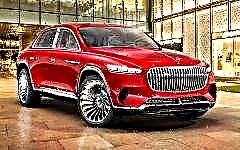

The content of the article:
- Toyota Origin
- Toyota Comfort
- Totota JPN Taxi
- Toyota Porte / Spade
- Toyota Sera
- Toyota Will
- Toyota Ecom
- Toyota iQ Supercharger GRMN
- Toyota Kijang
- Toyota Classic
For more than 80 years of its existence, the largest Japanese automaker Toyota has developed and produced about a hundred different models. Some of them became absolute bestsellers, some were simply in demand, and some either went unnoticed by motorists or had a limited release. About rare models of the famous brand - in our review.
1. Toyota Origin

The luxury model has become a present from the company to its loyal fans in honor of the release of the 100 millionth car. Produced in 2000 in only a thousand pieces, it borrowed the overall style from its 1955 Crown sibling in its very first generation.
But the technical part of the model came from the executive limousine Progres and received the most modern filling at that time: airbags, an electronic assistant for controlling the distance to the vehicle in front and other systems that make driving safe and enjoyable.
The carefully thought-out interior, which is dominated by leather, wood, hand-made decorative elements and the general style of the 50s, also attracts attention. In general, the car was distinguished by its impressiveness and solidity, which, despite its not at all bright appearance, ensured a stable demand for the entire batch.
The manufacturer set the price for a unique car produced in just a month - 60 thousand dollars.
2. Toyota Comfort

In 1995, this model was launched into serial production in order to provide driving schools with training vehicles, as well as by order of taxi companies.
These rear-wheel drive sedans were equipped with 2-liter gasoline or diesel engines, paired with a 5-speed "mechanics" or 4-speed "automatic". In addition to the main modification, they also developed a long wheelbase version and a gas-fueled vehicle.
The car, designed for 5 or 6 people, was not in great demand, and therefore by 2009 its production was stopped. Comfort's second life began in 2011 and lasted until 2017, when the model was permanently removed from the assembly line.
3. Toyota JPN Taxi

One of the relatively new developments of the Japanese brand, also intended for the operation of taxi fleets. In fact, this model can be called the successor to the Toyota Comfort, which received a modern look and specific design.
In accordance with its purpose, the car acquired a high cabin, more convenient for landing, a hinged passenger door and a sliding rear door, several ceiling hinges for comfortable disembarkation of people, as well as handles on the backs of the front seats. In addition, a ramp was designed for the car, making it possible to transport disabled people in a wheelchair.
Received this "service" model and a non-standard power plant: an electrical part in the form of a 1.5-liter LPG engine from Prius and an electromechanical variator.
4. Toyota Porte / Spade

Both hatchback models rolled off the assembly line in 2012 and were primarily intended for the Japanese car market. The engineers presented them with a very unusual design - with standard swing doors on the driver's side and one large sliding, electrically operated, on the opposite side.
Two power units were placed in the "heart" of both cars:
- 1.3-liter 95-horsepower front-wheel drive;
- 1.5-liter 109-horsepower front and all-wheel drive.
The motors were equipped with a stepless variator.
Another version of these two cars was specially created for people with limited mobility, and therefore was equipped with a lowered front passenger seat.
5. Toyota Sera

The debut of the model on the Japanese market took place in 1990, showing the consumer a compact coupe with very original butterfly-wing doors, for which the car was mistakenly considered for a long time to be the discoverer of this kind of mechanism.
Moreover, the doors had really large glass, as if going onto the roof, which, together with the hemispherical rear glass, made the car light and light. It was one of the manufacturer's first experiments with a body in a biodesign style, characterized by a streamlined shape.
The front-wheel drive model received an injection 1.5-liter 110-horsepower gasoline engine, paired with a 5-speed "mechanics" or 4-speed "automatic". In addition, with the promised capacity of 4 people, the rear seats were too small and uncomfortable to accommodate an adult.
However, despite the good technical stuffing, as well as the image of a luxurious sports car created by unusual doors, the design for its time turned out to be too conceptual. Therefore, 4 years after 16 thousand copies released, the model was discontinued.
6. Toyota Will

In the photo: Toyota Will 2000
A funny compact sedan, looking like a beetle or a ladybug, existed for only one year - from 2000 to 2001. Designers awarded it with round shapes, a sloping front end with a seemingly chopped off rear radiator grille, unusual for Toyota, and a bumper too prominent for such a crumb. A 1.3-liter 88-horsepower engine and a 4-speed automatic was installed in the "heart" of the car.
With a more than extravagant appearance and controversial opinion of motorists, this model marked the beginning of a whole series under the general name Will.
The first car, although it borrowed the front-wheel drive base from Vitz, did not even acquire the automaker's nameplate in the short period of its life.
Subsequent models, produced until 2005, were offered to consumers in the body of a classic sedan, hatchback and semi-open version with a folding fabric roof.
7. Toyota Ecom

In the photo: Toyota Ecom 1997
As part of their work on sustainable transportation, Toyota engineers have designed this model, which can only be found in Japan.
Introduced at the 1997 Tokyo Motor Show, Ecom attracted the interest of car-sharing services, which purchased several dozen of these compact and economical cars for themselves.
Released in a small batch, now the car can only be seen in the local museum.
8. Toyota iQ Supercharger GRMN

Pictured: 2012 Toyota iQ Supercharger GRMN
When creating this car, the engineers tried to combine compactness with the convenience and functionality of a full-fledged model, therefore, with a length of less than 3 meters, it had to comfortably accommodate 4 passengers.
For the 3-door hatchback, they chose an original chassis, equipped with keyless entry, almost a dozen airbags, a variety of electronic assistants, and also embodied an incredibly beautiful interior design.
In 2012, a separate batch of a hundred iQ Supercharger GRMN models was released, which received a retuned suspension, disc brakes on all wheels, and a supercharger that increased the engine power to 120 hp. Thanks to such indicators, all cars were instantly sold out, even at a considerable cost of 3.5 million yen.
Although objectively it should be admitted that the emphasis on compactness made the capacity of the model very conditional, since tall people were extremely uncomfortable in the rear seats.
9. Toyota Kijang

Despite the fact that this model has as many as three generations, outside of Southeast Asia, it is practically unknown to the general public.
Few people have seen or heard of such a model as the Toyota Kijang, despite the fact that it has as many as three generations. The car was intended for the Southeast Asian market.
The most unusual was the first generation, produced from 1976 to 1981. The car was a light pickup, equipped with an in-line 4-cylinder engine.
10. Toyota Classic

In the photo: Toyota Classic, 1996
Another jubilee model, timed to coincide with the 60th anniversary of Toyota AA and released in a circulation of one hundred copies.A 1930 Mercedes, which belonged to the Japanese emperor, was chosen as a model for this car.
Made in 1996 on the basis of a Hilux pickup truck, the car received an incredible retro style, chic finish, a 97-horsepower 2-liter gasoline engine, a 4-speed "automatic" and rear-wheel drive.
The car was targeted at the domestic market and was not exported. Its price was 75 thousand dollars.
Conclusion
Toyota cars have long been firmly entrenched in the hearts of motorists, and therefore even unclaimed, even misunderstood, experimental and strange models take their place in private collections, in museums, as well as in automotive history.
Toyota











